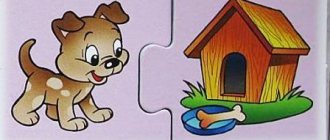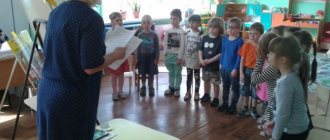Summary of a lesson on speech development in the middle group of a preschool educational institution. Sound F
Summary of a lesson on speech development in the middle group Topic: “Sound culture of speech: sound [f].”
Goal: to practice clear and correct pronunciation of the sound [f] in syllables, words, phrases; teach children to identify the sound [f] in words by ear, to intonate it in a word; practice the correct use of the noun number in the nominative and genitive cases; develop intonation expressiveness of speech. Material : letter, toy hedgehog, bag of treats (grass, doll, mushroom, nut, ball, apple), key, hedgehog masks, images of a house, grandfather, woman, mice, 3 hedgehogs, box. Dictionary : hedgehogs-hedgehogs, mice-mice, T-shirt, apron, jacket, scarf, shoes.
Progress of the lesson.
There's a knock on the door. The postman comes in and gives the children a letter. Educator : Guys, look, they brought us a letter. What is written there? (The teacher takes out a letter with a riddle and reads it). Educator: He walks, carries needles on himself, curls up in a ball, no head, no legs. Who is this? Children : Hedgehog. Educator : That's right, it's a hedgehog. Here he is, guys, hiding from us. Let's listen to a song about a hedgehog. The song “Little Hedgehog” is playing. A small hedgehog, four legs, A hedgehog walks through the forest, sings a song, Fu-you, fu-you, fu-you, fu: I carry a leaf on my back, I’ll bring everything you need! A small hedgehog, four legs, a hedgehog walks through the forest, sings a song: Fu-you, fu-you, fu-you, fu, I carry a leaf on my back, I am the strongest in the forest, - I’ll bring everything you need! Educator: What song does the hedgehog sing? Children : Fu-you, fu-you, fu-you, fu (choral and individual answers). Educator: Guys, look at the hedgehog. That he has? Children: Head, paws, tail, needles. Educator : What does a hedgehog eat? Children : Mushrooms, apples. Educator: The big hedgehog has a long song. He sings “ffffff”. Let's sing together. (Children repeat) Educator: When hedgehogs like something, they say “fi-fi-fi,” and when they don’t like something, they say “fu-fu-fu.” What do hedgehogs say when they like something? (children's answers). And when hedgehogs don’t like something, they say what? (children's answers). The hedgehog took a long time to get to us and was hungry. Let's feed him. Didactic game "Magic Bag". The child takes a treat out of the magic bag, shows it to the other children, and they try to guess whether they liked the treat, responding with certain onomatopoeia “fi-fi”, “fu-fu” (grass, doll, mushroom, nut, ball, apple). At the end of the game it turns out that hedgehogs like to eat. Educator : The hedgehog ate and now wants to play with you. Outdoor game "Funny Hedgehogs". Educator : I have a magic key. You will be groovy hedgehogs. I’ll lead you on and you’ll sing a song: “f-f-f” (the teacher puts hedgehog masks on the children). Educator: The hedgehog really liked playing with you. Now listen to the story about hedgehogs. Educator : On the edge of the forest, in a small hut, there lived a grandfather and a woman. And in the forest, not far from the house, there lived three hedgehogs. Their names were Fuk, Fok, Fek. What were their names (choral and individual answers). Hedgehogs guarded the forest. What were the hedgehogs doing? (children's answers). And, walking along the forest paths, they sang songs. Here is one of them: There are no better watchmen in the world than us, forest hedgehogs. There are no better guards in the world than us, forest hedgehogs. One day, mice snuck into the hut where the grandfather and woman lived. Even during the day they walked around the house and squeaked. The old people decided: “Let’s invite the hedgehogs. Let them drive away the mice." Educator : What did the old people decide to do? (children's answers). And so the hedgehogs go to fight with the mice. Phuc is ahead. Who's ahead? (children's answers). Behind him is Fok. Who's behind Phuc? (children's answers). And behind is Fek. Who's behind? (children's answers). The hedgehogs follow each other, sing a song: We are walking along the path - Fuk, Fok, Fak! Let's go to my grandparents, Fuk, Fok, Fak! Let's go to my grandparents, Fuk, Fok, Fak! And quietly we sing, Fuk, Fok, Fak! (The teacher repeats the song, the children say the names of the hedgehogs in chorus). Educator: So the hedgehogs drove away the mice and set off on the way back, also singing the song: We are walking along the path, Fuk, Fok, Fak! And quietly we sing, Fuk, Fok, Fak! (children finish the names) Educator : Guys, look, the hedgehog brought a box for us, let's see what's in it. Children : Treat. Educator: Let's say thank you to the hedgehog for the gift. Children : Thank you. Educator : And it’s time for the hedgehog to leave, let’s tell him “Goodbye!” Children : “Goodbye!” Educator: What did we talk about today guys? Who came to visit us? What did you like?
We recommend watching:
Summary of a lesson on speech development in the middle group on the topic: “Ukraine is my native land” Notes on the development of speech in the middle group Notes on the lexical topic “Transport” for children 4-5 years old with severe speech impairments Notes on the development of speech in the middle group middle group
Similar articles:
Summary of a lesson on speech development in the middle group on the topic “Our Street”
Target. Strengthen the articulatory and vocal apparatus of children by offering tasks to clarify and consolidate the pronunciation of the sound [f]; learn to pronounce sound combinations with different volumes; determine the distance to the observed object (far - close) and use the corresponding words in speech.
Progress of the lesson
The teacher shows the children a small toy dog, says that its name is Funtik and offers to listen to the dog bark. The teacher explains: “To get a beautiful af, you need to open your mouth wide” (repeats the onomatopoeia). Children first all together, and then take turns pronouncing onomatopoeia.
The dog “approaches” the beret (or Panama hat) lying on the table and tries to lie down on it. The teacher shakes his finger at the dog and sternly says: “Ew, Funtik, fu.” The dog once again tries to lie on the beret. Children repeat the ban in chorus and individually (3-4 repetitions).
The teacher removes the headdress and shows the children a large dog. Explains that a big dog barks loudly, while a small one barks more quietly. Then he asks how a big dog barks and how Funtik barks. (Choral responses alternate with individual ones.) The teacher ensures that all children pronounce sound combinations correctly, clearly and at different volumes.
“Look,” the teacher continues the conversation, “our dogs saw someone.” Draws children's attention to a penguin (duckling, frog or any other wind-up toy) standing at a distance. He asks the dogs to be warned not to bark at the penguin and not to scare him: “Fu-fu, you can’t bark!” (Individual repetitions.)
The teacher moves the table away, freeing up the area, and Filya, come closer."
The penguin stops. “Children, reach out and pet the penguin,” the teacher suggests. - Don't get up from your chairs. Can I get it like this? Why?" Confirms: “Yes. He stands far away. Say: “You’re standing far away.” (Choral and several individual statements.)
Then several children (3-4) take turns asking the penguin to come closer. Filya readily responds to every request. He approaches the children. “You see how close the penguin came to Olya (Dima, Igor),” says the teacher. “Now they can pet him.” Don't rush, Nastenka. The penguin will come to you too. Dima, were you able to reach the penguin now? And why? (He is close, standing nearby.) Now the penguin will go to the other children so that everyone can pet him.”
The teacher removes the penguin, and then invites the children to pretend to be penguins. The “penguins” go for a walk, return, and tell the teacher about what they saw when they walked far, far away to the sea.





